Warwick Castle- 1,000 Years of British History
This is my fifth post from a recent tour of Britain with Canadian military travel specialists Liberation Tours. It’s titled Medieval Britain: Castles, Cannons and Crowns and will take us from London to Edinburgh in just over two weeks, stopping at some one the best known sights in the country and a few lesser known ones as well. Yesterday was a day for the ages as we started off by visiting Stonehenge with famed British archaeologist Frances Pryor and followed it up with a visit to the most beautiful church in England, Salisbury Cathedral. There we got to see the best preserved copy of the Magna Carta. Afterwards we journeyed north through the Salisbury Plain to Shakespeare country outside of Stratford-upon-Avon where we will stay for two nights. Today’s excitement starts with a visit to legendary Warwick Castle where events that have shaped England’s history for 1,000 years have taken place. Won’t you join us on a tour of this unique place?
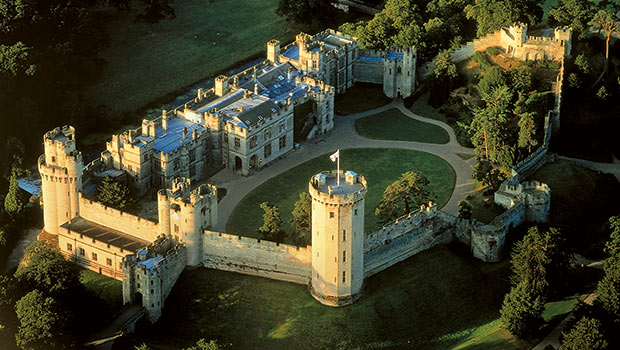
History of Warwick Castle
The history of settlement in the Warwick area goes back thousands of years and includes a Roman fort built by Agricola, but the history of the fortification of the area where the castle now stands really starts with Alfred the Great’s daughter Æthelflæd, the Lady of Murcia. The first thing you’ll notice about Warwick Castle is that it is located on a hill above a bend in the River Avon – a natural place to build a fortified position. Apparently Æthelflæd recognized this as well and built an earthen rampart or ‘burh’ around the small settlement on the hill. All traces of that are long gone, but if you want to know more about this fascinating woman read Bernard Cornwell’s Last Kingdom series where she appears as a prominent character, especially in Volume 4, Sword Song. The Last Kingdom has also been made into a great TV series that is entering its third season late in 2018. Great entertainment for lovers of British historical fiction, but I digress.
The first building that could actually be called a castle was built in 1068 by none other than William the Conqueror who constructed what is known as a motte and bailey castle on the site. Made out of wood, not stone, it would have looked something like this.
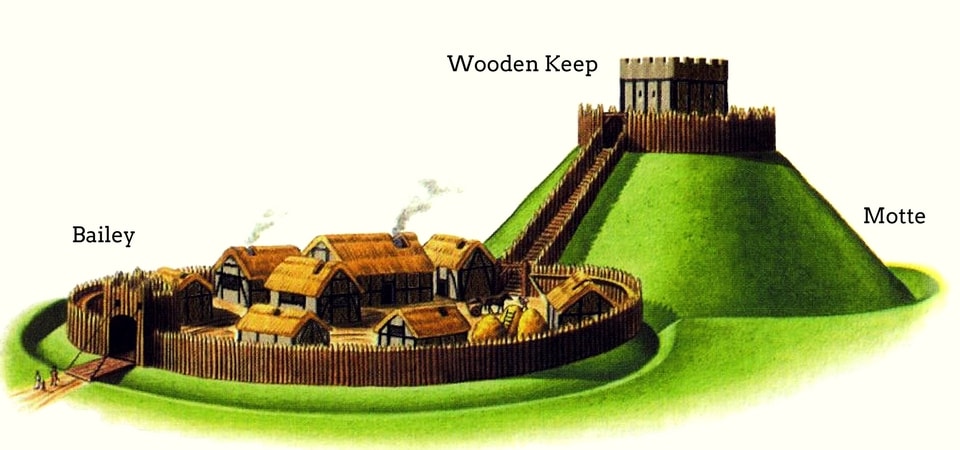
Again, all traces of this second fortification are long gone, but it is believed that it stood on this site, known as Conqueror Hill, which you can see clearly from the top of the Guy Tower. Obviously the stone tower and walls date from much later, but you can clearly see the rounded hill that fits the description of a motte.
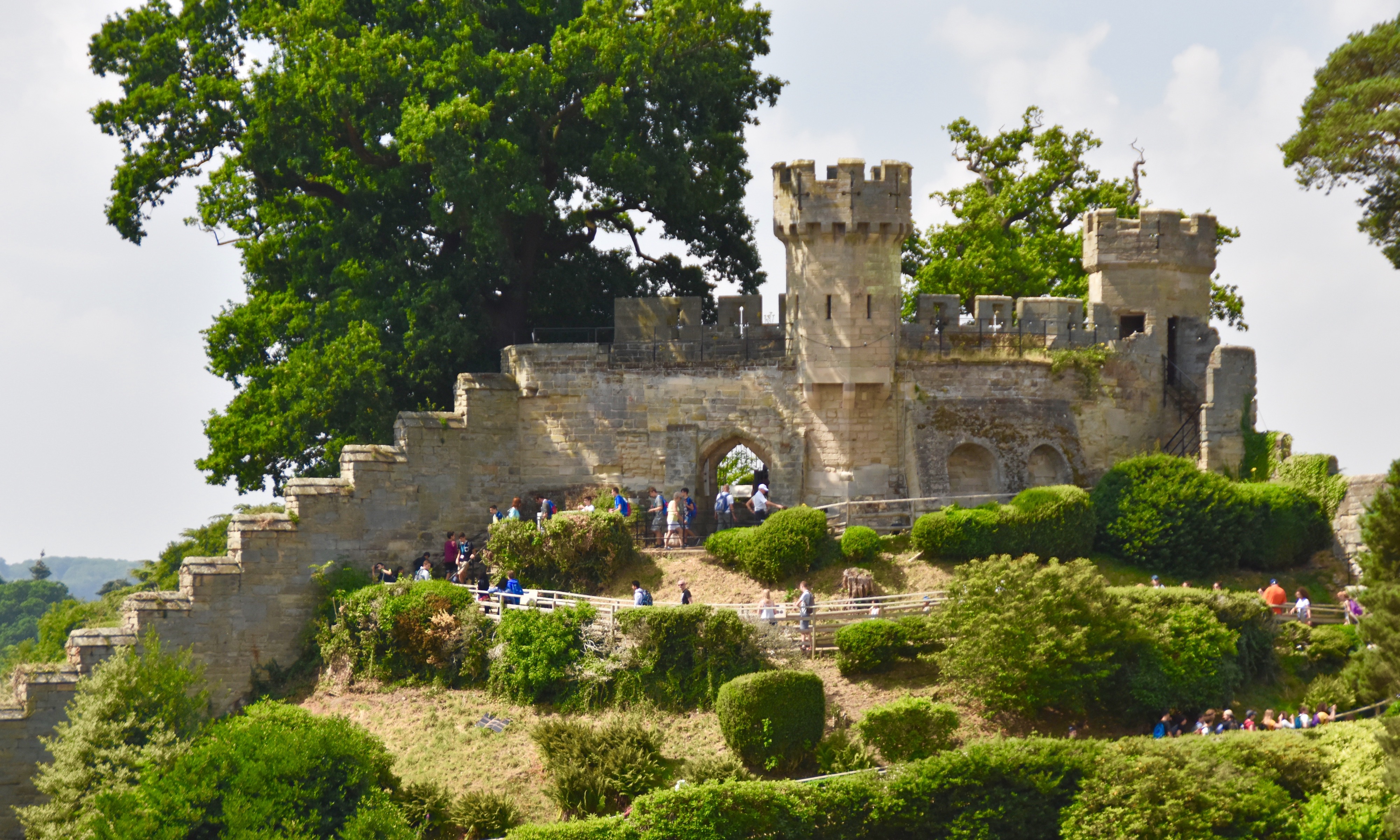
With William’s conquest of England came grants of lands and titles to his Norman noblemen who by 1066 were completely francophized and thus began the period of time when French and Frenchmen ruled England. The first to own the Warwick property (or technically, hold it for the King as Constable) was Henry de Beaumont who became the first Earl of Warwick in 1088, a title that would be held by many of the most influential men in English history. There were five generations of de Beaumonts who became noteworthy for their continued allegiance to the king through a number of baronial uprisings. This in turn led to more land grants and more power.
In 1242 the last de Beaumont earl died without an heir and the title passed to his sister Margaret and her husband John Du Plessis, but they too died childless and title passed to her cousin William Maudit in 1263. By this time there was a stone keep on the site, but nothing resembling the castle we see today.
Then events really began to ramp up. In 1264 the Second Baron’s War broke out against Henry III led by one of the most mercurial figures in English history, Simon de Montford. Maudit sided with the king and de Montford attacked Warwick Castle and succeeded in taking it, largely with the help of siege machines called trebuchets, about which more later. Maudit was captured and held for ransom. Also captured by de Montford was King Henry and his heir Edward and he actually ruled England for over a year before being killed at the Battle of Evesham. De Montford is credited with establishing the first English Parliament although it in no way resembled the institution of today. But he also conducted the first of a series of pogroms against English Jews in a thinly disguised attempt to wipe out their debts to them. To me, this remains one of the most fascinating periods in English history, much of it occurring in and around Warwick Castle.
Henry was returned to the throne and the title of Earl of Warwick passed to William de Beauchamp on the death of his uncle Maudit who had been restored by Henry. Thus began a period of 180 years in the hands of the de Beauchamp family which also ushered in the period of castle building that created most of the building standing today. The de Beauchamps were nothing if not interesting, constantly at the centre of various palace intrigues and machinations that made them among the most powerful and feared families in England.
Guy de Beauchamp, 10th Earl of Warwick was responsible for one of the most notorious incidents in medieval English history – the abduction, trial and execution of Piers Gaveston, homosexual lover of Edward II. The trial took place in Warwick Castle and Gaveston was executed (murdered really) on a road a short distance away. If you want more details have a look at Derek Jarman’s 1991 film Edward II based on Christopher Marlowe’s play. It’s a riot.
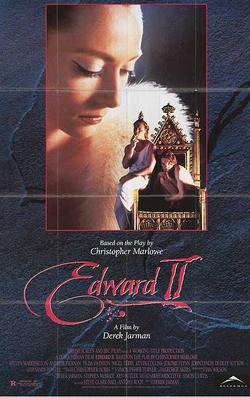
After Edward died, probably murdered by his estranged wife’s lover Roger Mortimer who imprisoned him, his son Edward III rapidly took charge and had Mortimer executed. What followed was one of the longest and most successful reigns in British history and the high point of the Age of Chivalry. Warwick Castle was the centre of tournaments, feasts and all the things we associate with this era of knights in shining armour and damsels in distress. The de Beauchamps were unrivalled in their skills as jousters, swordsmen and archers. This made them natural leaders of men, leading troops in many successful battles in France during The Hundred Years War. It was also the setting for the next infamous act by a de Beauchamp.
Although she was convicted by a religious court and declared a heretic to be burnt at the stake by that court, Richard Beauchamp, 13th Earl of Warwick is largely credited (or discredited) with being behind the death of Joan of Arc. He was the English commander at Rouen, then in English hands, and was at her trial and her execution.
The Beauchamps were succeeded by Richard Neville as 16th Earl of Warwick in 1449. He was one of the most prominent of all the Warwickians, earning the sobriquet ‘The Kingmaker’ first for deposing Henry VI in favour of Edward IV and then in turn imprisoning him in Warwick Castle. Forced to release Edward, Neville was then killed at the Battle of Barnet, but not by Edward personally as this contemporary woodcut would suggest. That’s Warwick on the right being impaled by Edward’s lance.
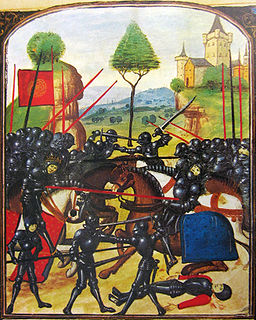
Being on the wrong side of history now changes the fortunes of Warwick Castle as it is awarded by the victorious Edward IV to his brother George, Duke of Clarence. George blows the prize by conspiring against Edward and is executed and the title and castle go to George’s young son Edward, known as the last Plantagenet. Being a threat to the eventual winner of the War of the Roses, Henry VII who literally came out of left field after nearly all the Lancastrian and Yorkist potential claimants killed each other off, Edward is imprisoned for most of his life in the Tower of London and then executed in 1499.
Since Edward was not old enough to run the castle when he attained the title and before he was imprisoned, good old Richard III stepped in and ran it for a short time until he was killed at the Battle of Bosworth Field. Confusing? Nothing is more confusing in English history than trying to follow the umpteen battles and claimants to the throne during the War of the Roses. For the purposes of visiting Warwick Castle all you need to know is that many of the most significant actors in that war resided here at one time or another.
But wait, there’s lots more treason, treachery and foul play to take place at Warwick Castle starting with John Dudley who was a great friend and confidant of Henry VIII and in 1847, the year of Henry’ death, named Earl of Warwick. After Henry’s death Dudley was the de facto ruler of England as Edward VI was too young and sickly to rule. When it became clear that Edward would not last, Dudley arranged for his son to marry Lady Jane Grey who had a tenuous claim to the throne and Edward inexplicably named as his heir in his will. In law we would call that undue influence. Lady Jane rules for only nine days, is imprisoned and executed as is Dudley. Another Earl of Warwick goes down flames.

By now the English monarchs have figured out that giving Warwick Castle to powerful noblemen is not the best of ideas and split the title of Earl of Warwick from ownership of the castle. In 1604 James I gives it to man known more for his poetry than his fighting prowess, Sir Fulke Greville and at last stability of title comes to Warwick Castle as the Greville’s hold it until 1978 when, for the first time in almost a thousand years, it is actually sold, but lots more happens in between.
Sir Fulke is murdered by a disgruntled servant in his London home, but for reasons no ghost hunter has been able to explain to me, decides to haunt Warwick Castle instead of the site of his murder. In 1642 the castle is besieged, unsuccessfully, by Royalist troops and that appears to end its time as an actual defensive fortress. The Greville’s make many improvements over the years, gradually transforming it into a grand country home. Over the years it has been visited by many ruling monarchs including Elizabeth I, Queen Victoria and the present Queen. Future kings Edward VII and George V are also visitors.
The sale in 1978 was to the Tussaud Group which subsequently went through amalgamations with other entertainment companies and is now the Merlin Entertainments, which also owns various Legolands and of course, the Madame Tussaud wax museums. The present owners make no apologies for turning Warwick Castle into, in effect, a theme park, but I am anxious to see if that detracts from the historical significance of the place. So let’s go find out.
Visiting Warwick Castle
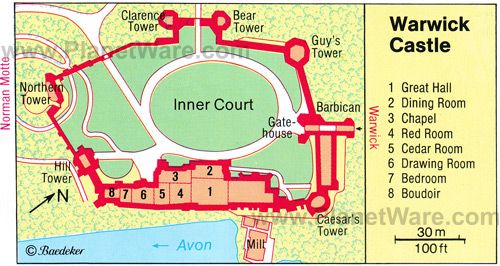
Visiting Warwick Castle has lots of options, but for those whose primary interest is the castle and grounds and not things like the Haunted Castle or the Dungeon which are separate attractions with a higher entry fee, I would suggest the following over a three hour visit.
- The Great Hall, Chapel and State Rooms
- The Royal Weekend Party
- The Ramparts and Towers
- The Grounds including taking in one of the daily exhibitions.
The Great Hall
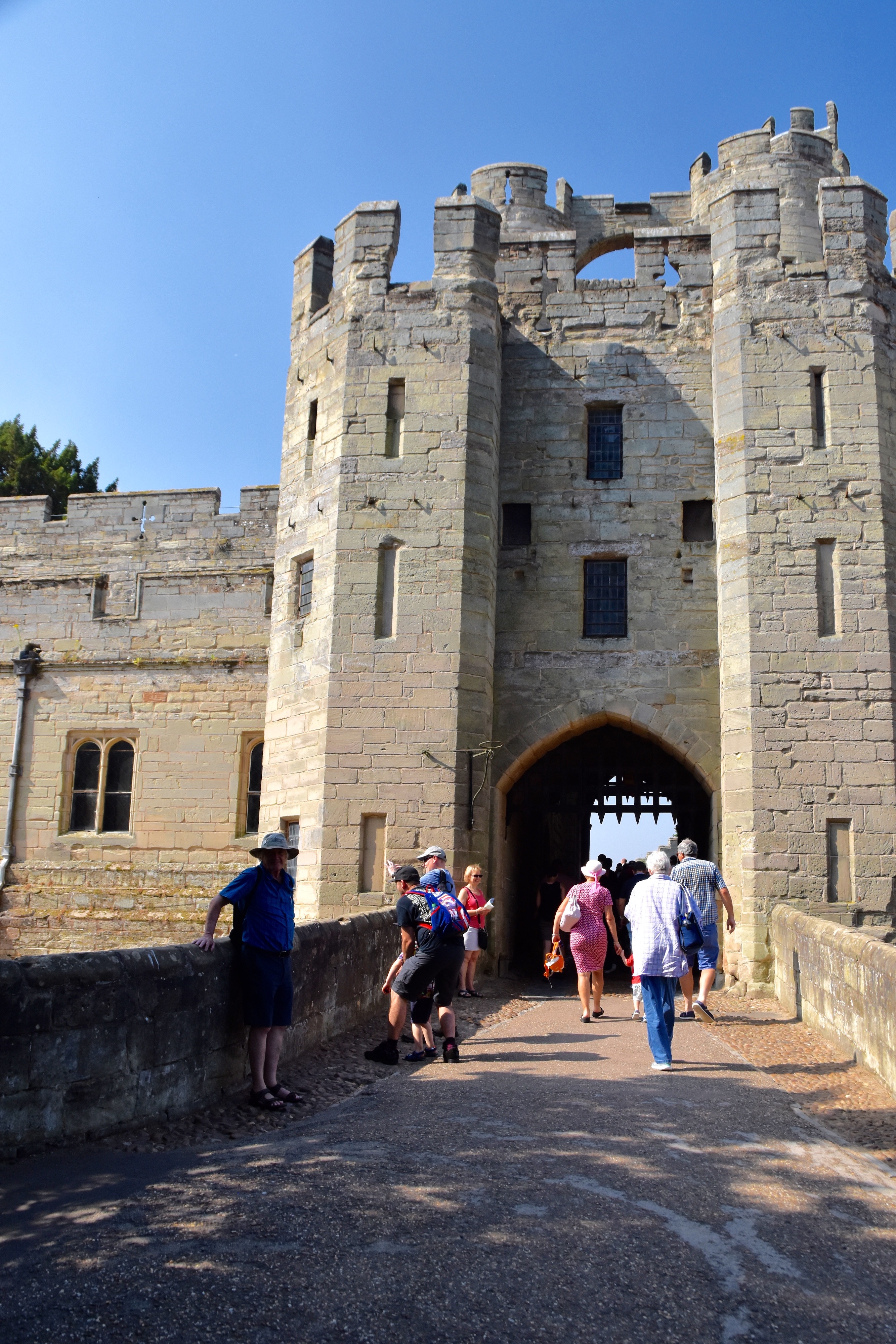
This is the castle entrance with me standing like a dolt in the shade rather than on the sunny side. After crossing the moat, now dry, you go through the gatehouse with its raised portcullis to the huge inner courtyard that you can see very well on the aerial photograph at the beginning of this post. On the left is the castle proper and here you enter the great hall and follow a designated route throughout.
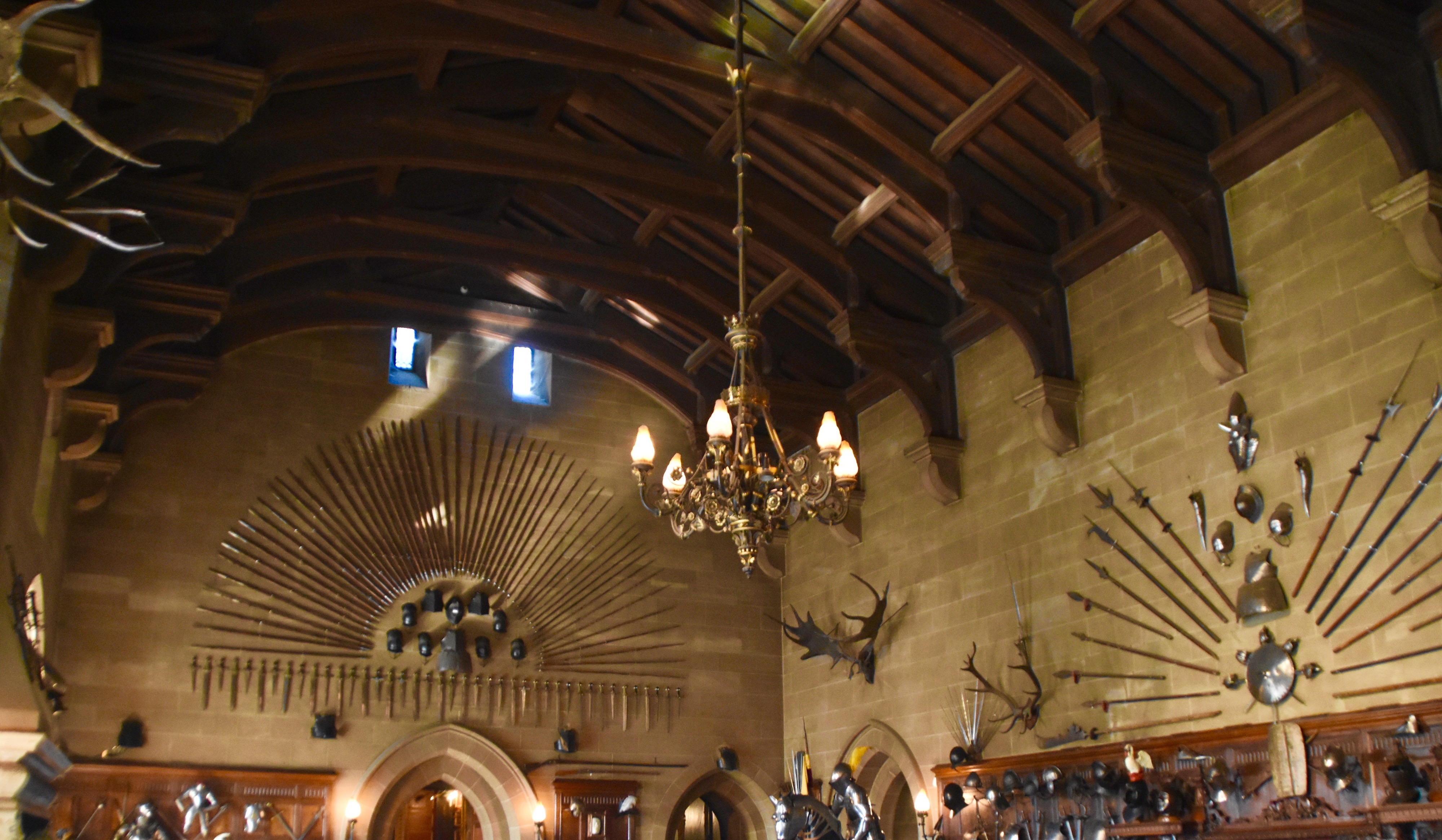
Here is a knight in shining armour.
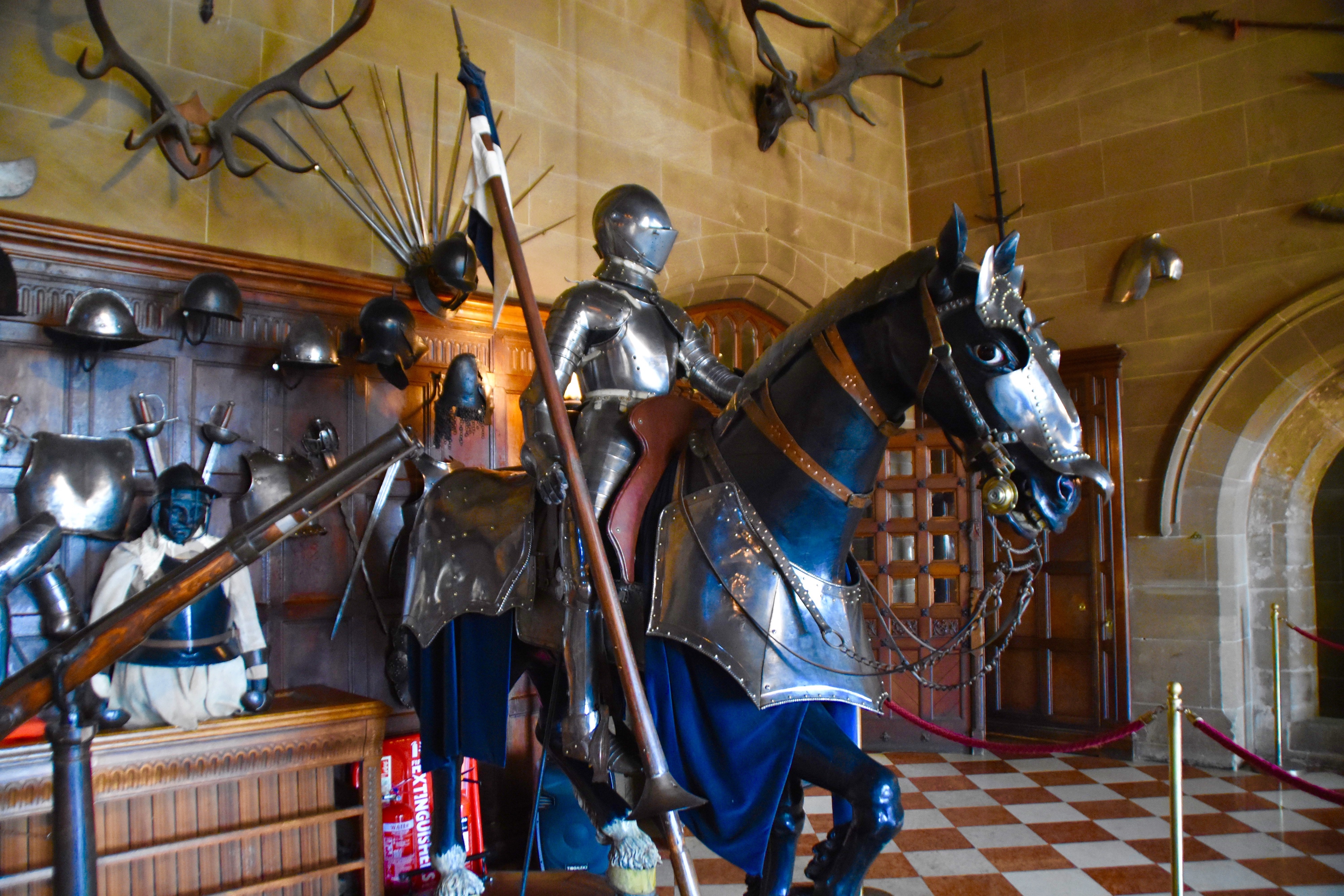
The Great Hall is truly impressive with great displays of weapons, armour and all the things you expect in a medieval castle. One thing I learned from visiting Warwick Castle and others on the Liberation Tour is that the owners of these castles go to great lengths to make the weaponry displays not only interesting, but works of art in themselves.
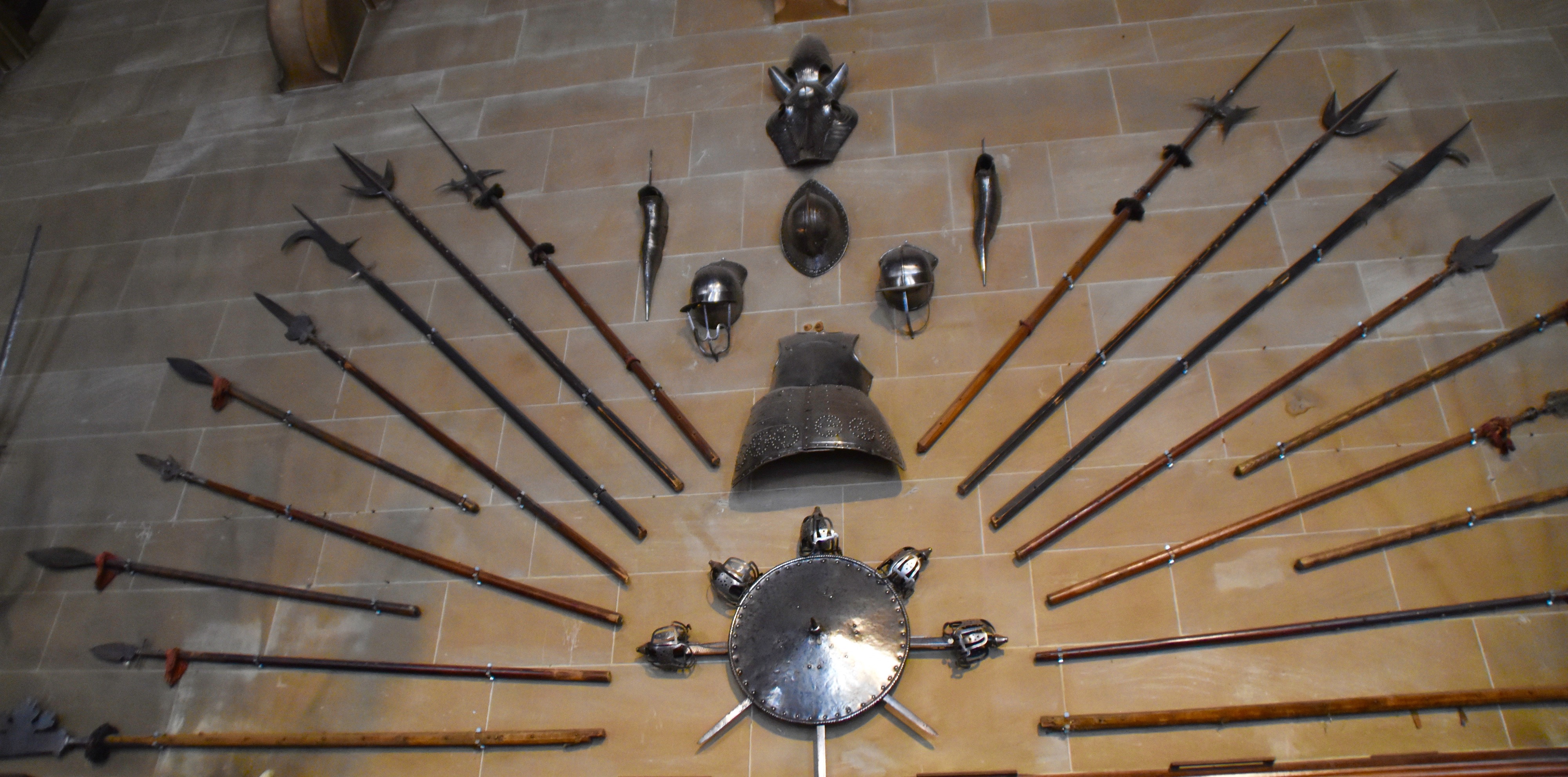
Along with arms and armour, most castles have displays of past hunting trophies.
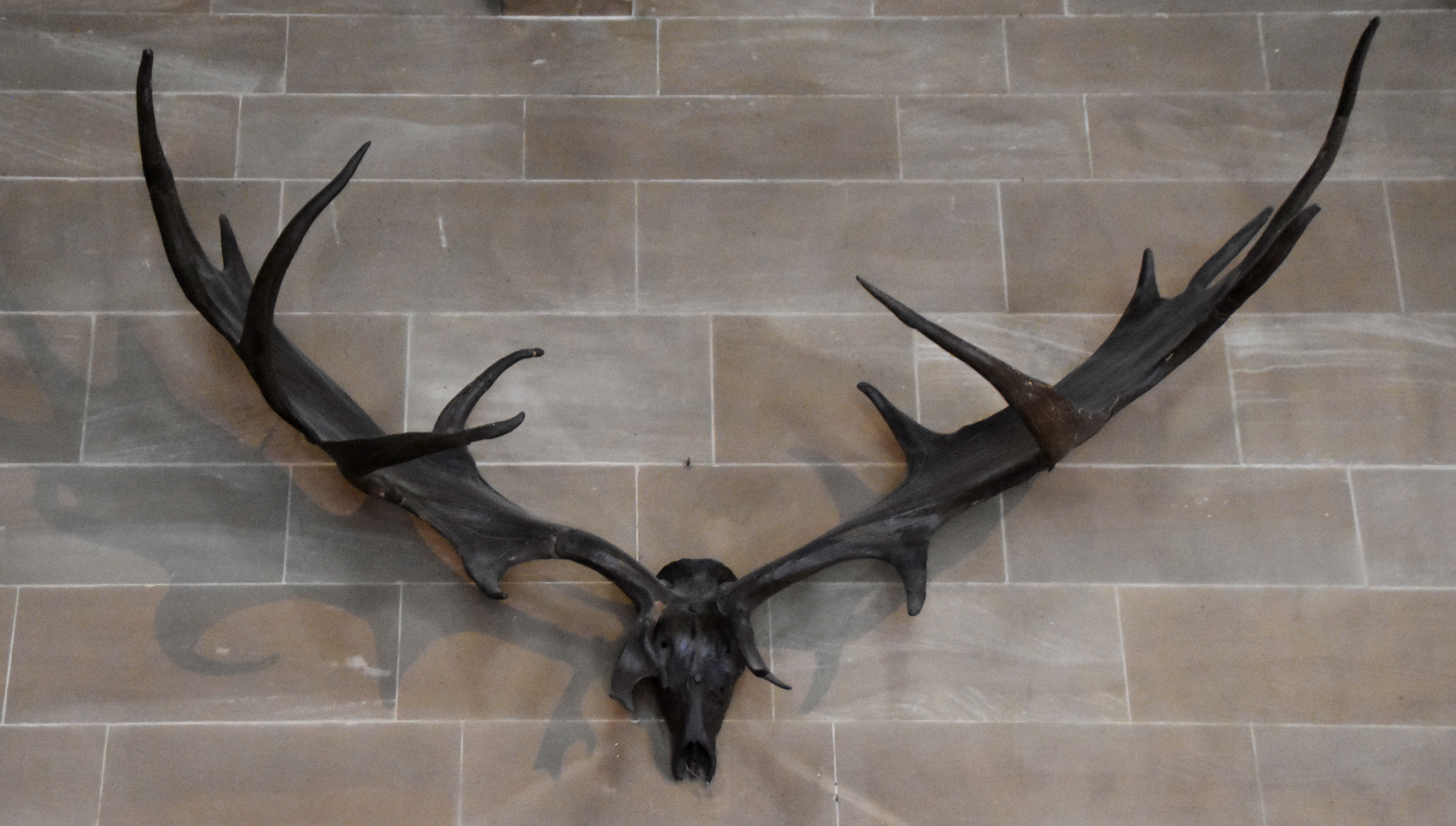
These are the antlers of an Irish elk, an animal that went extinct long before Warwick Castle was built so nobody actually hunted it. There are a surprising number of Irish elk antlers to be found in medieval castles.
Warwick Castle puts its association with Madame Tussaud’s to go use throughout the place starting with this tableau of Henry VIII with his six wives. I borrowed this photo from Pinterest as you need a special lens to get it all in one shot, but it’s pretty impressive. Remember it was Henry VIII who made John Dudley into the second most powerful man in England.
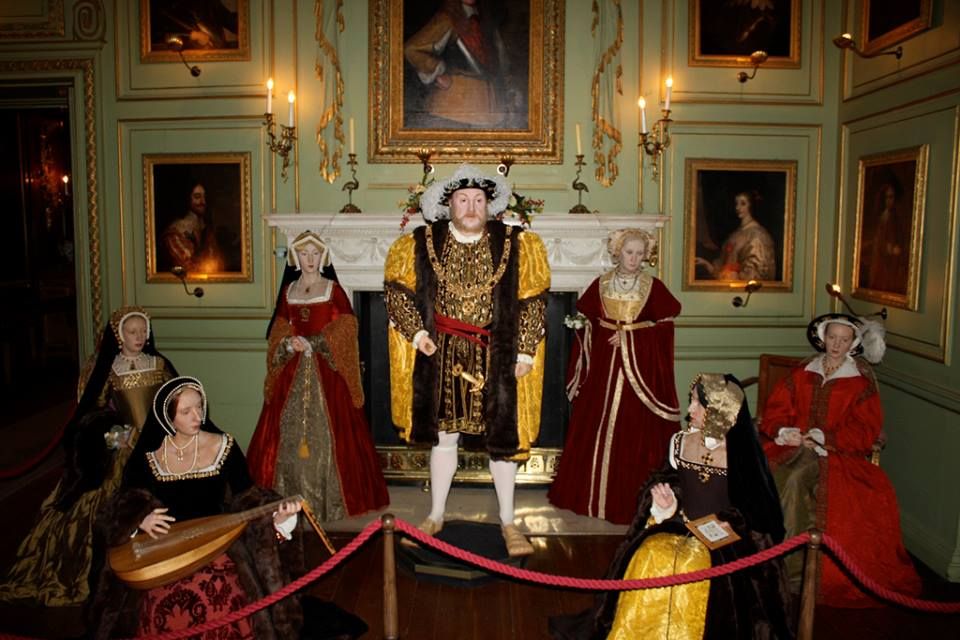
This modest set up is the dining room.
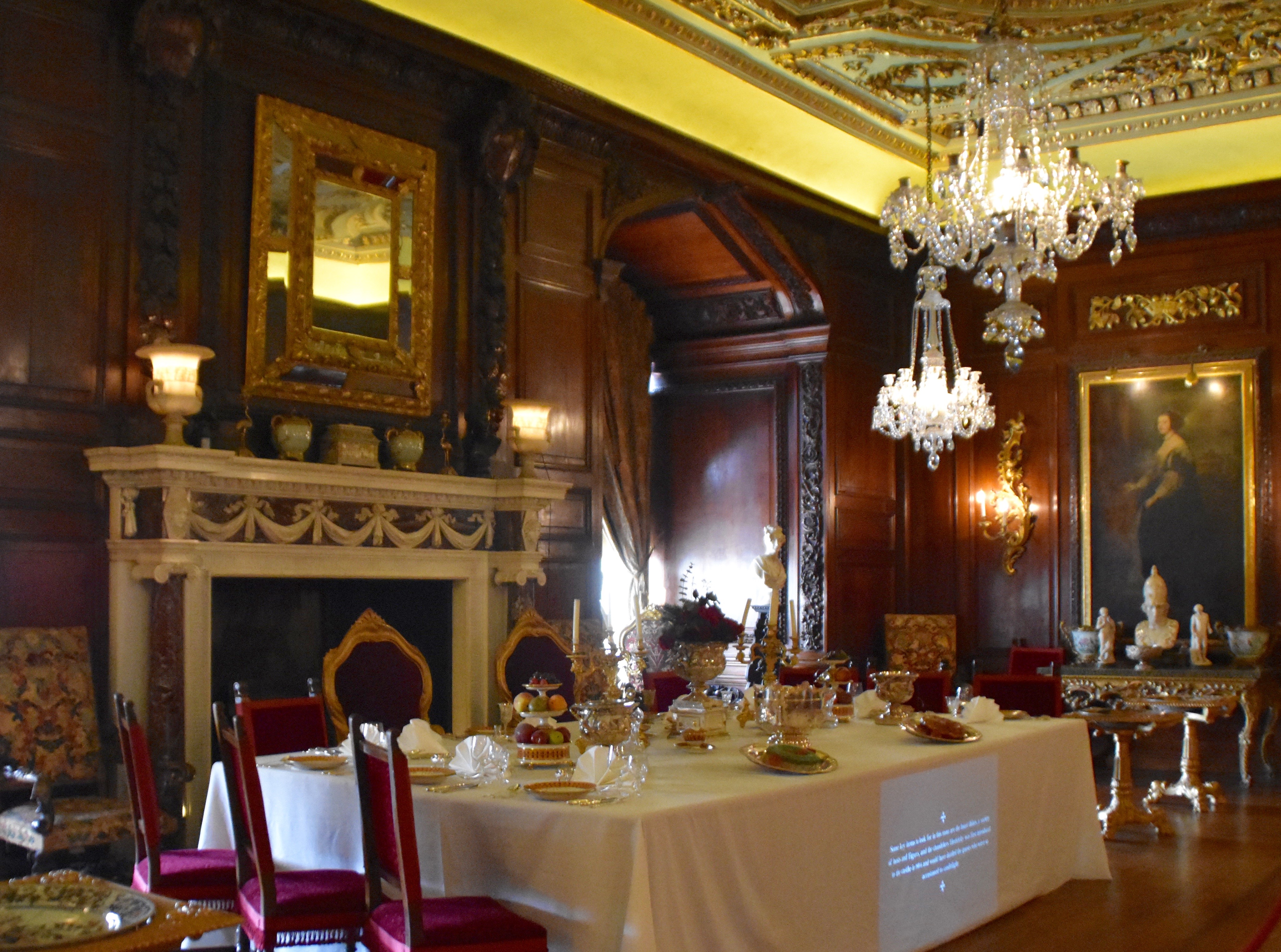
I omitted one Queen from my list of royal visitors and that was Queen Anne. That was because she died in this very bed, albeit the bed was in London at the time. How and why it ended up in Warwick Castle was not explained.
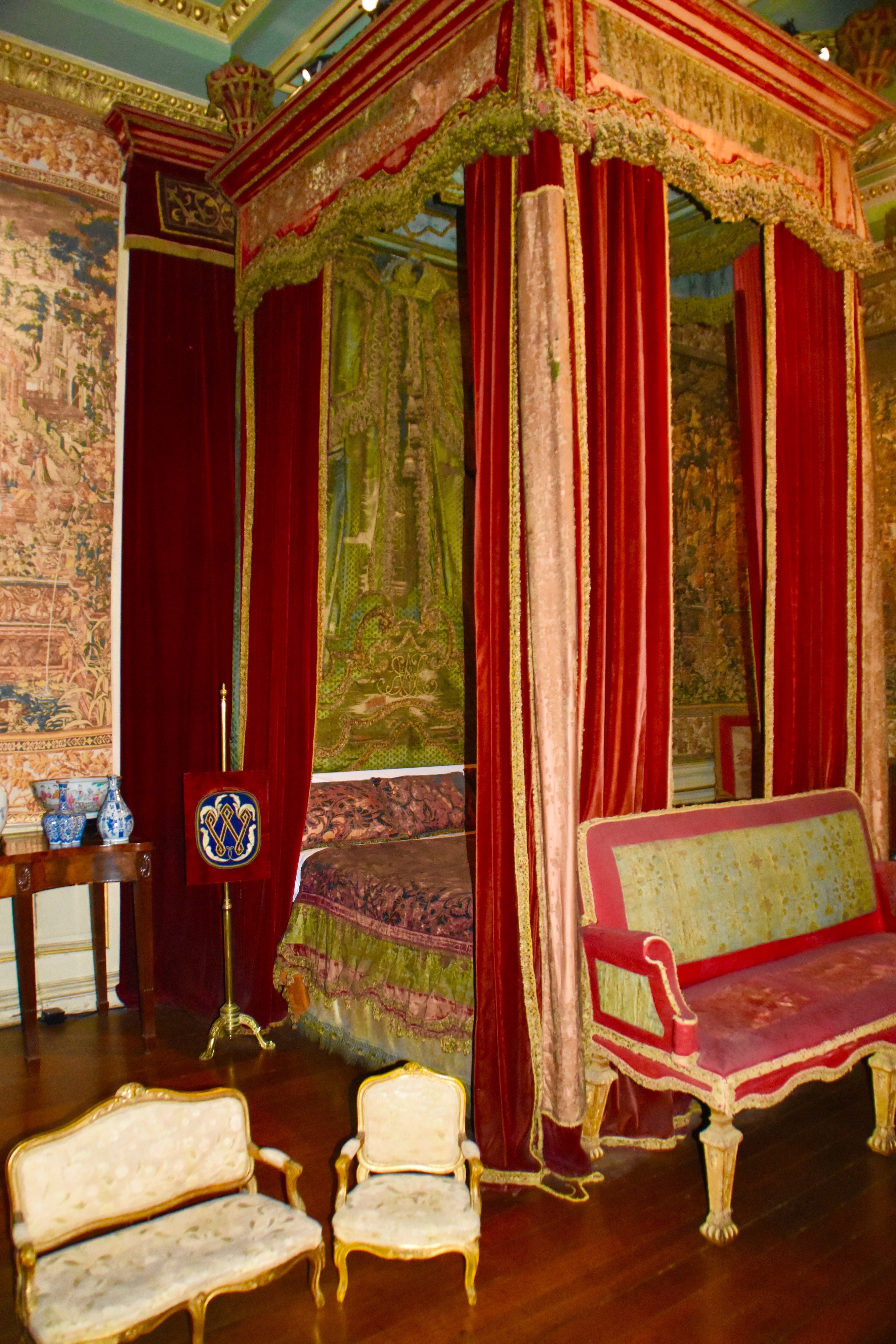
The Royal Weekend Party
Moving on to what I found to be one of the most interesting exhibits in Warwick Castle you come to twelve rooms furnished as they would have been when Frances, Countess of Warwick held a weekend party in honour of the Prince of Wales, the future Edward VII. Frances was known as Daisy to her friends and it was about her that the famous song Daisy, Daisy Give Your Answer Do was written. The guests were a who’s who of English society in 1898. Here’s a very young Winston Churchill in the library
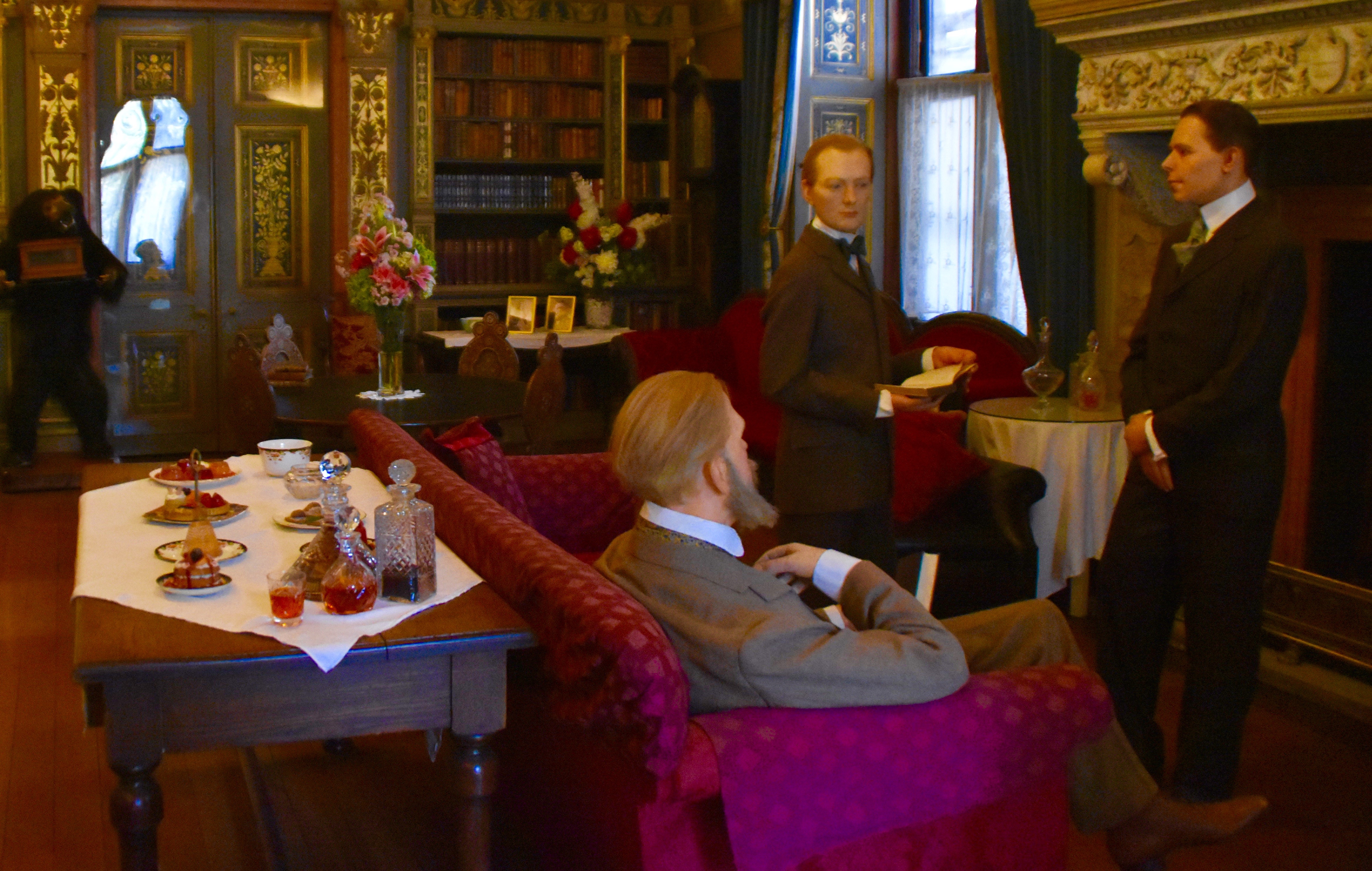
And here’s his mother Lady Churchill with her future second husband, George Cornwallis-West who she actually first met at this weekend getaway. He was only a month older than Winston, but was smitten by Jennie’s famous beauty.
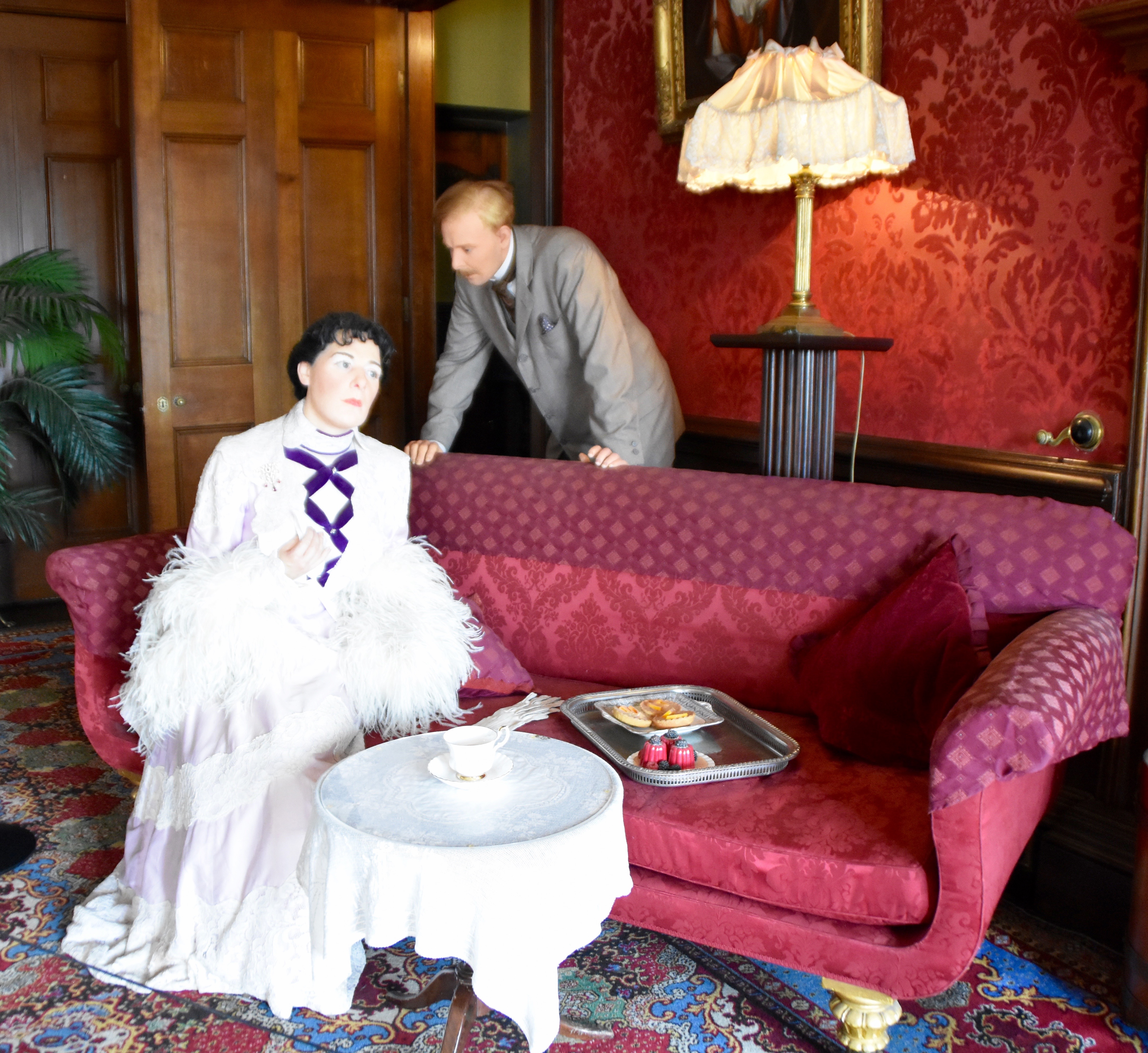
There are lots of other great figures including the future George V with his trademark beard and moustache, playing cards, but there’s more to see.
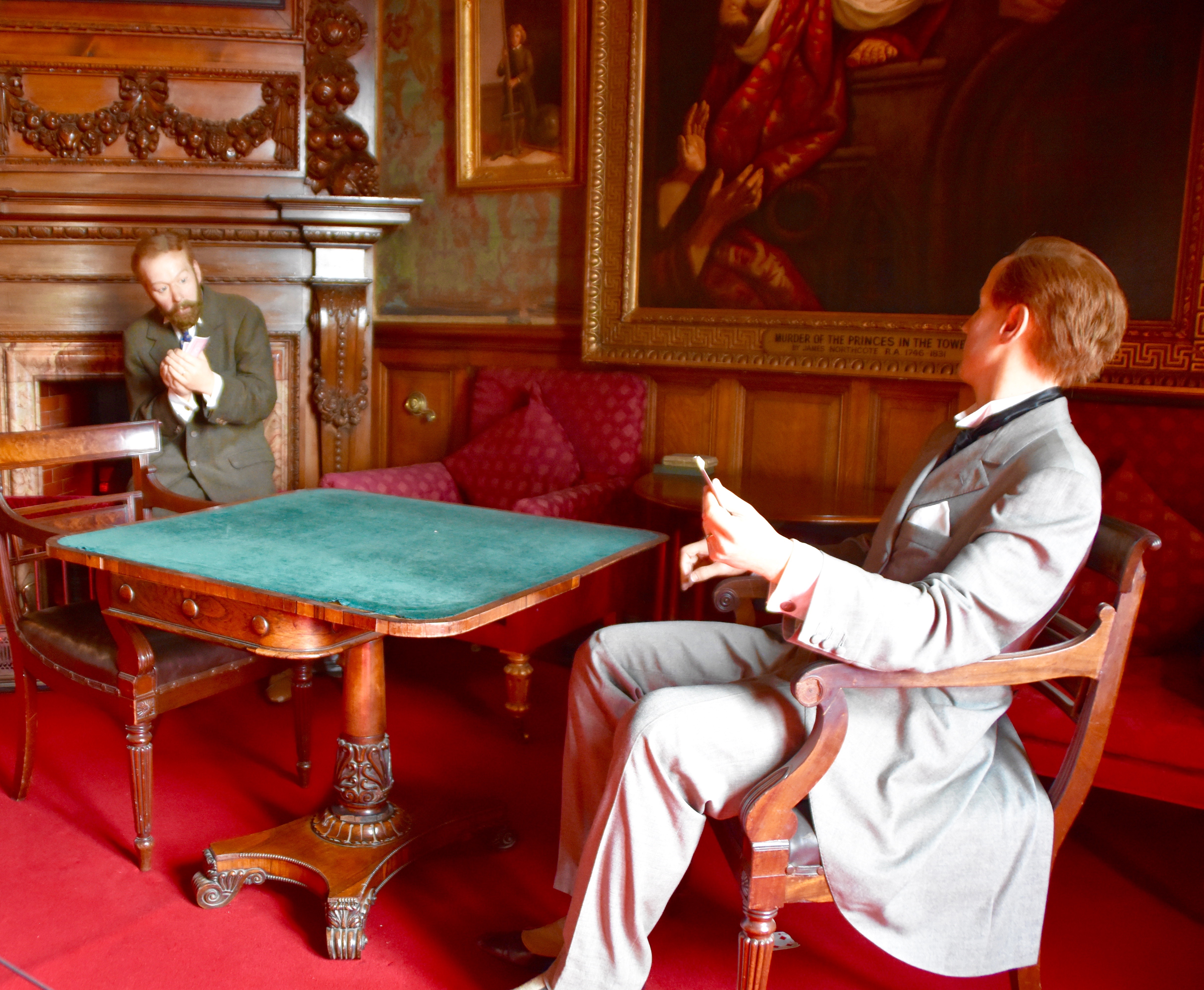
Warwick Castle Ramparts and Towers
It’s quite a climb up to the ramparts and then to Guy’s and Caesar’s Towers, but more than worth the effort. The views are spectacular.
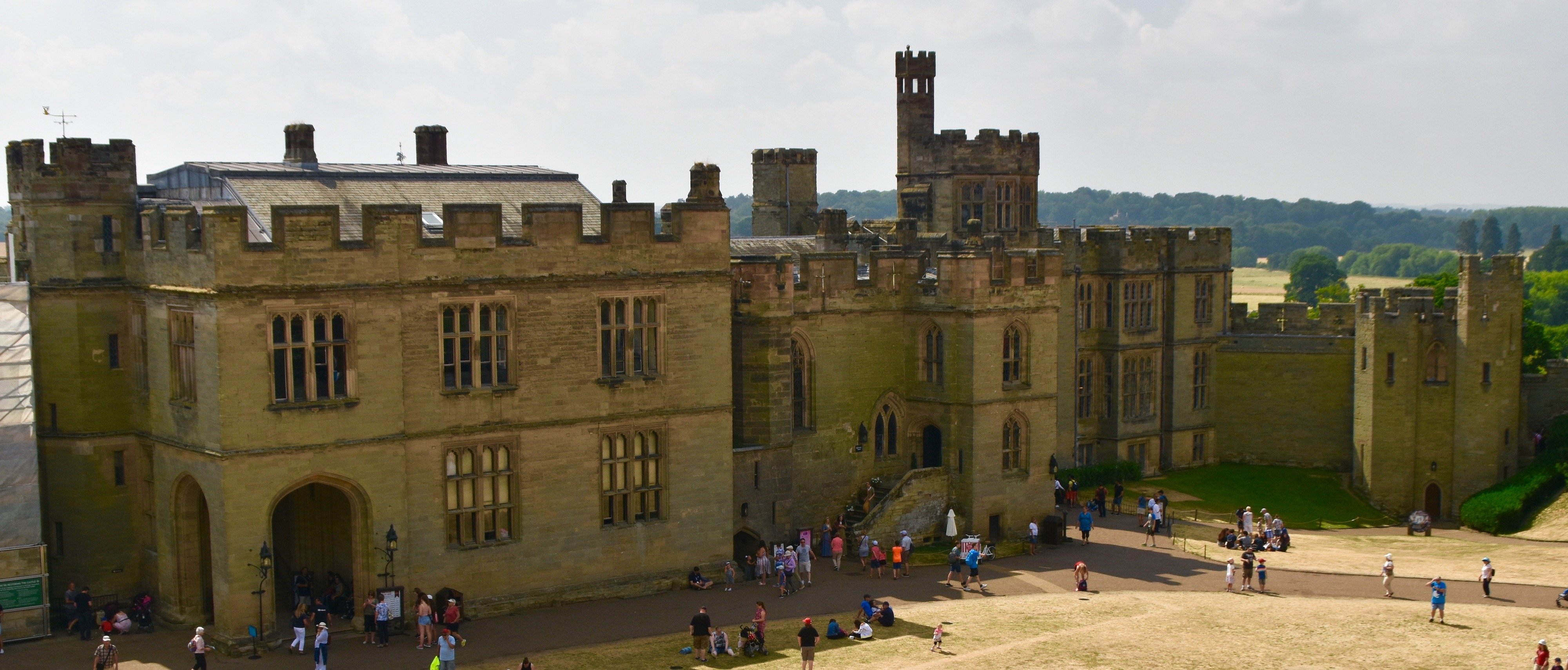
Even better from the towers, but first you have to get up there.
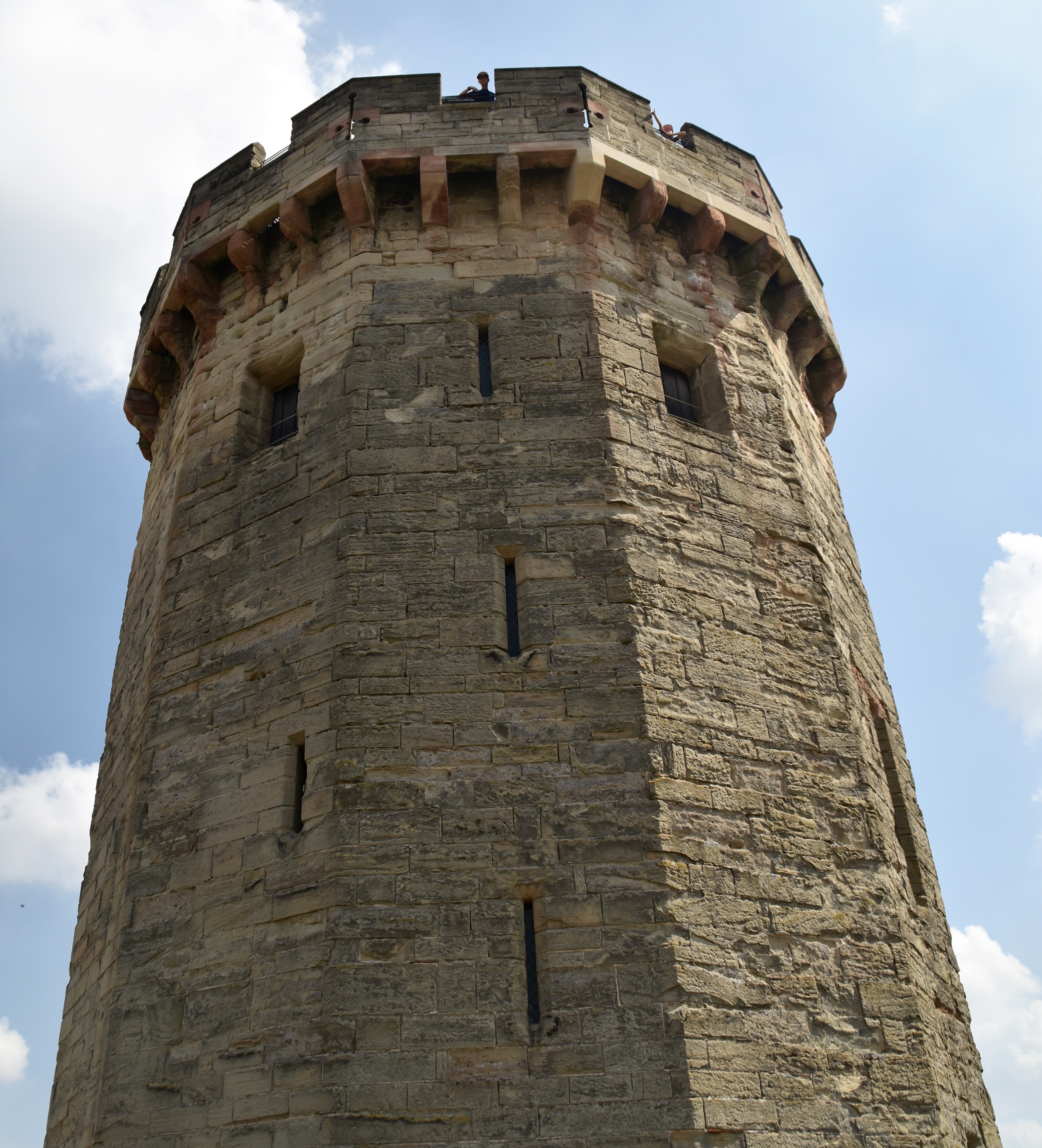
Alison waves to indicate that she needs a breather after all those steps and so will you.
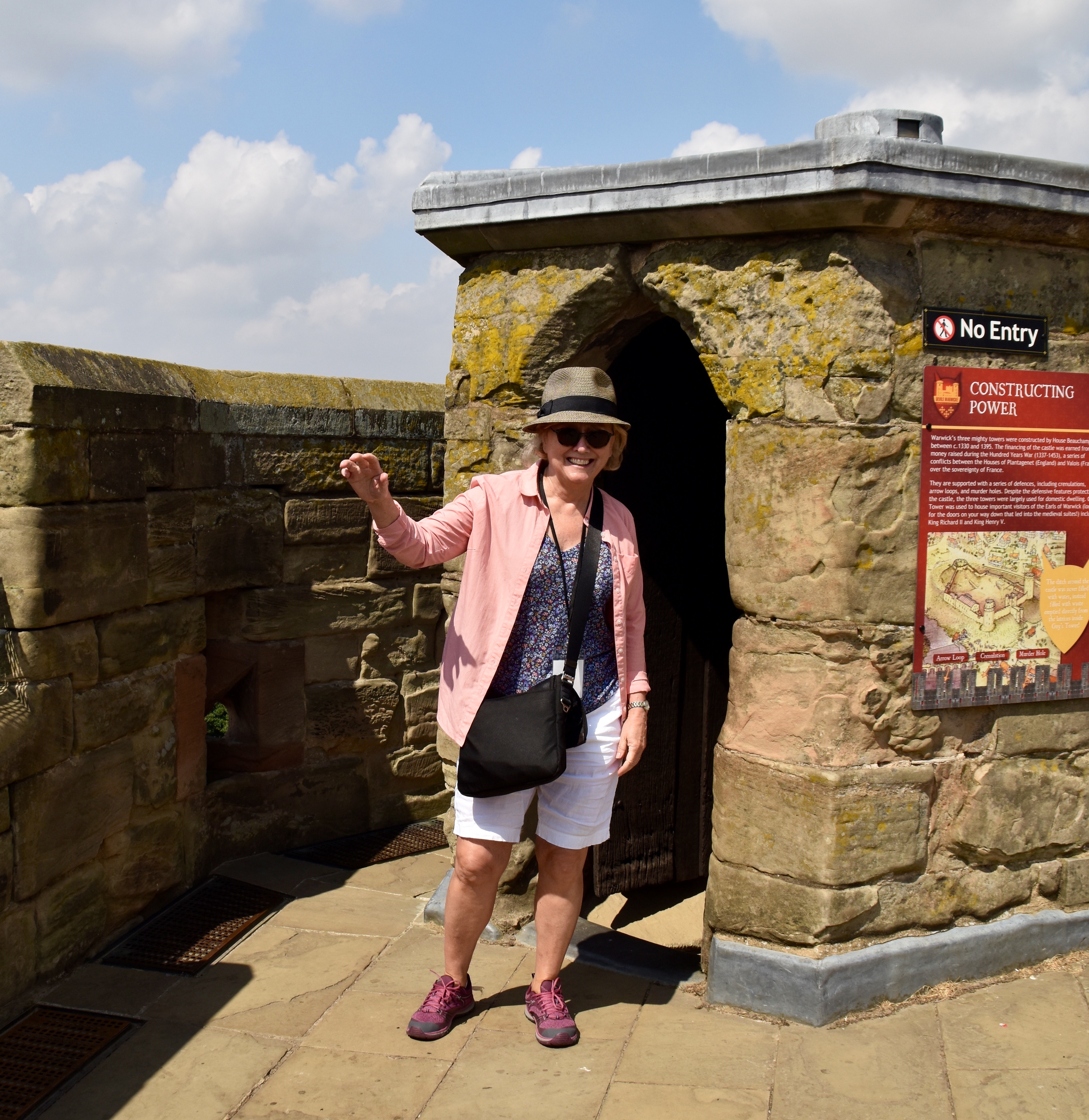
Guy’s Tower was a great spot from which to watch the falconry display which was going on just outside the palace grounds, but the birds themselves would swoop over castle walls before returning to the falconer.
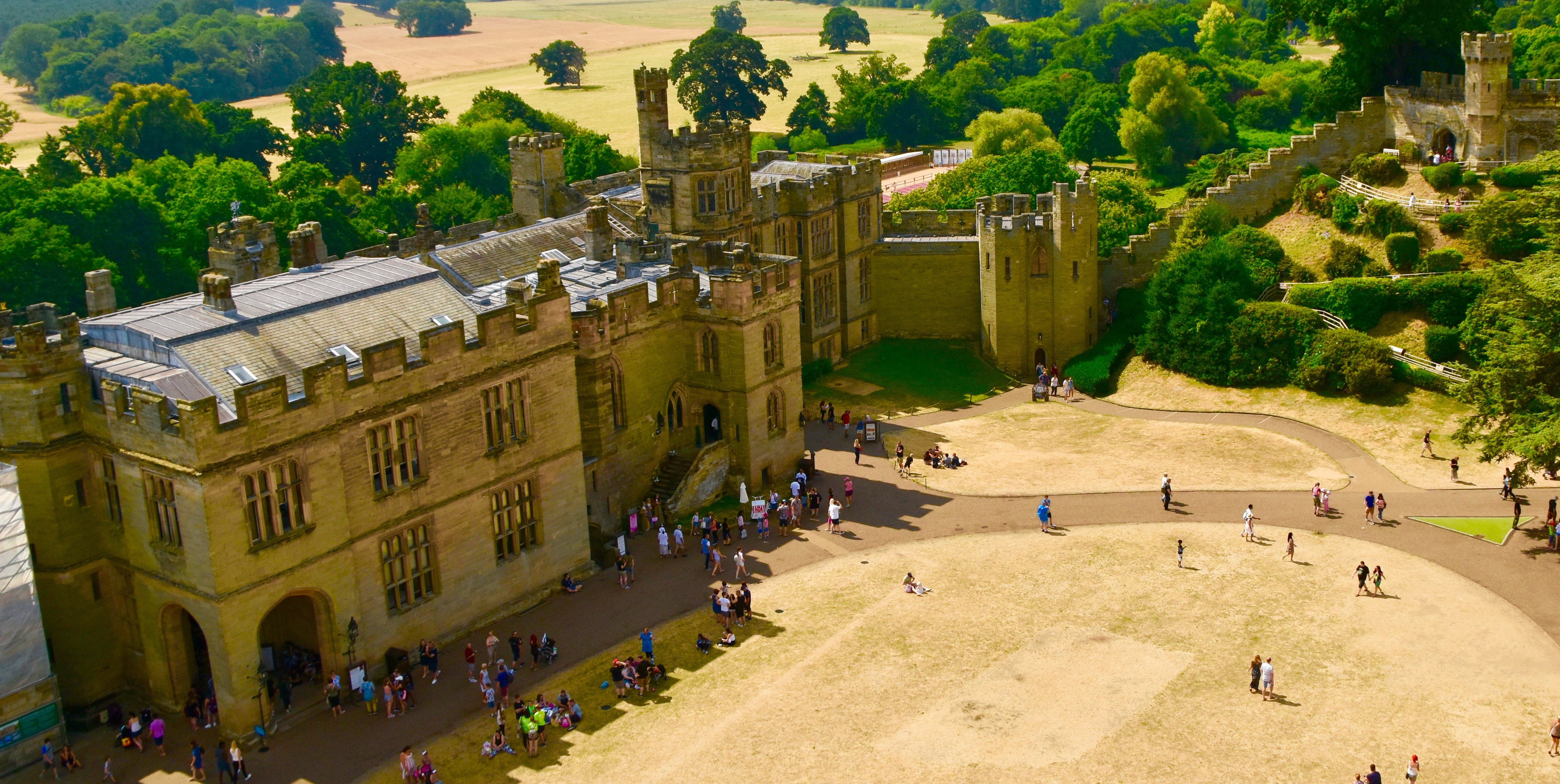
Caesar’s Tower is even higher.
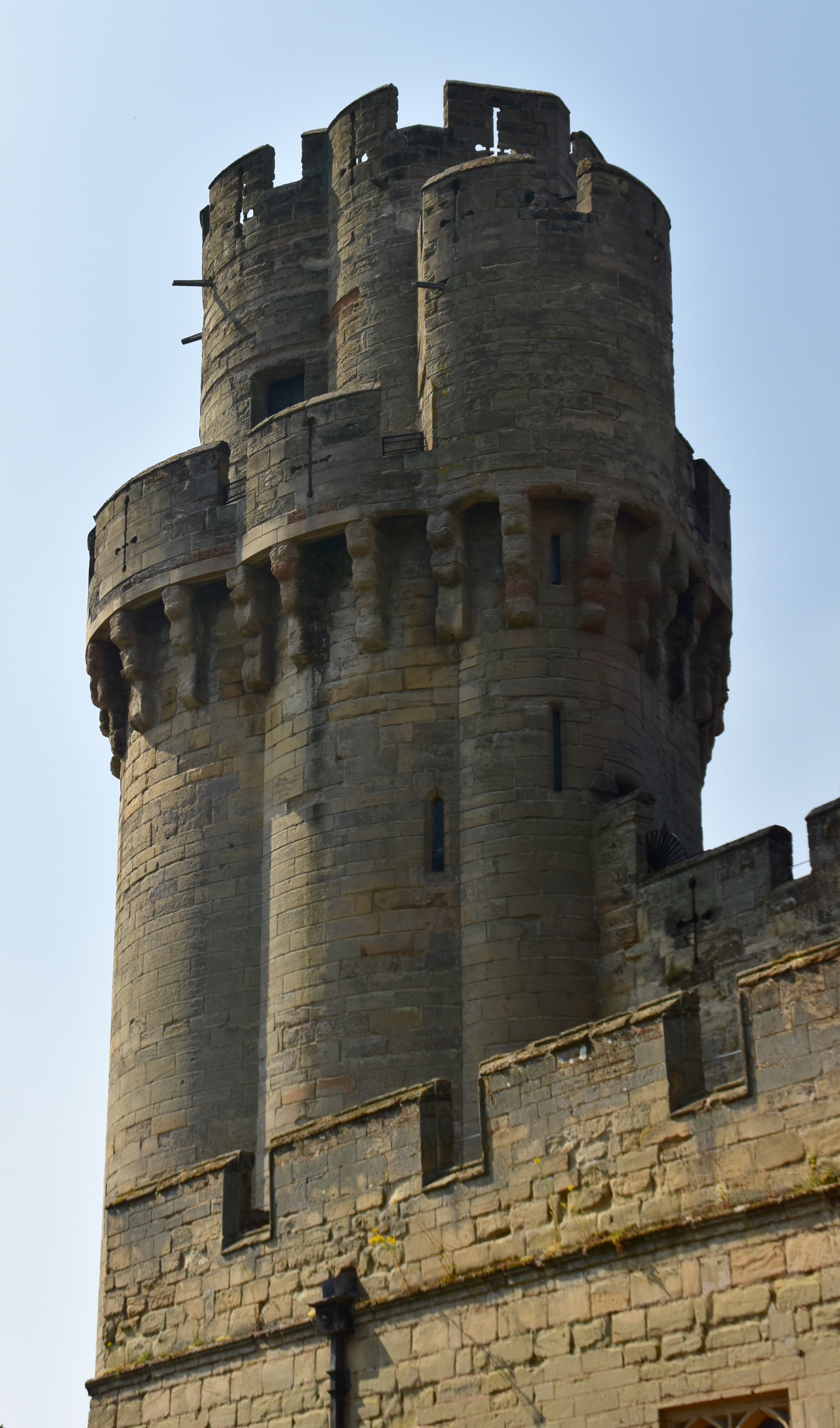
Warwick Cathedral from Caesar’s Tower
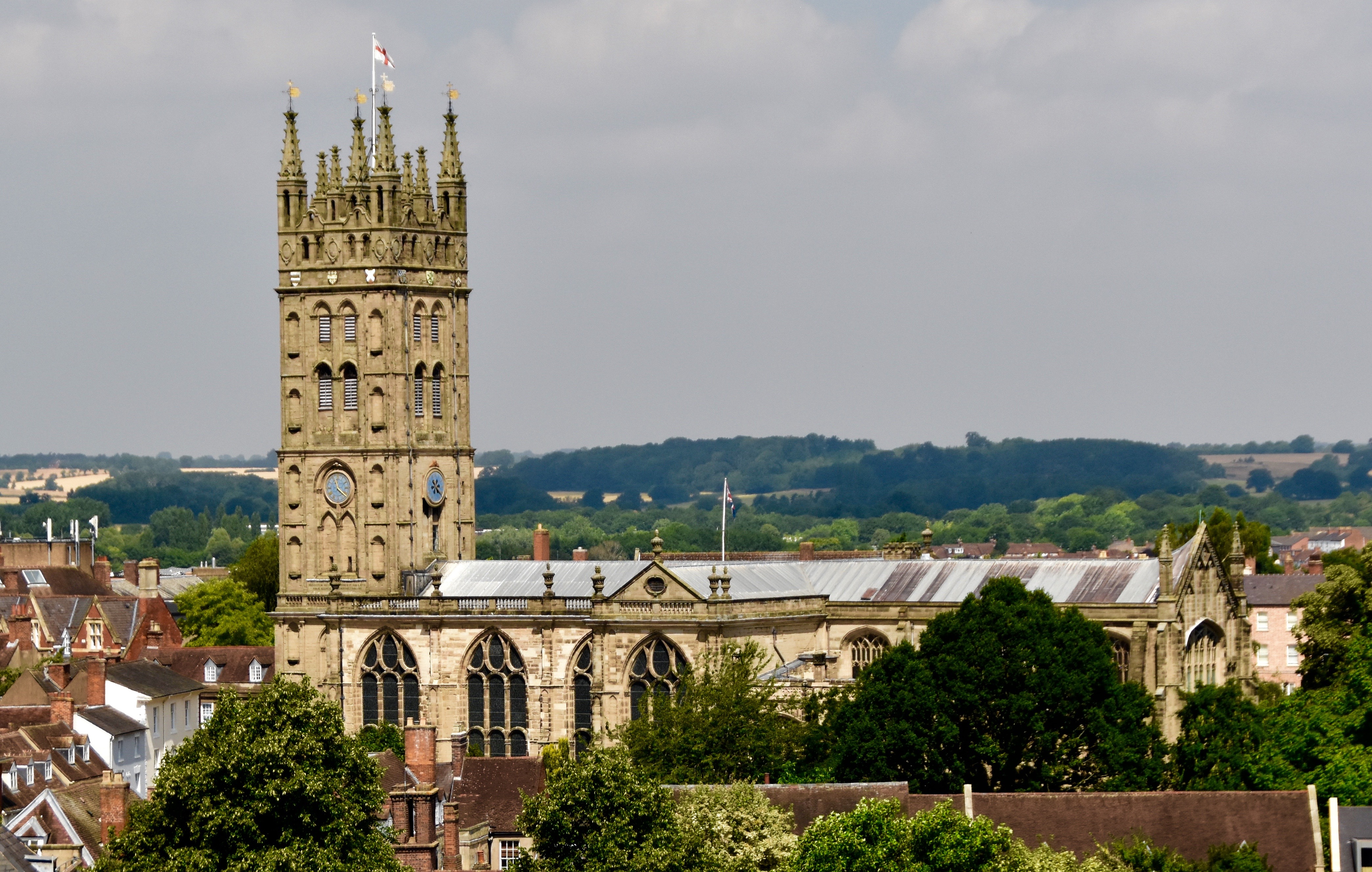
This view of Warwick below gives an idea of just how high up this tower is.
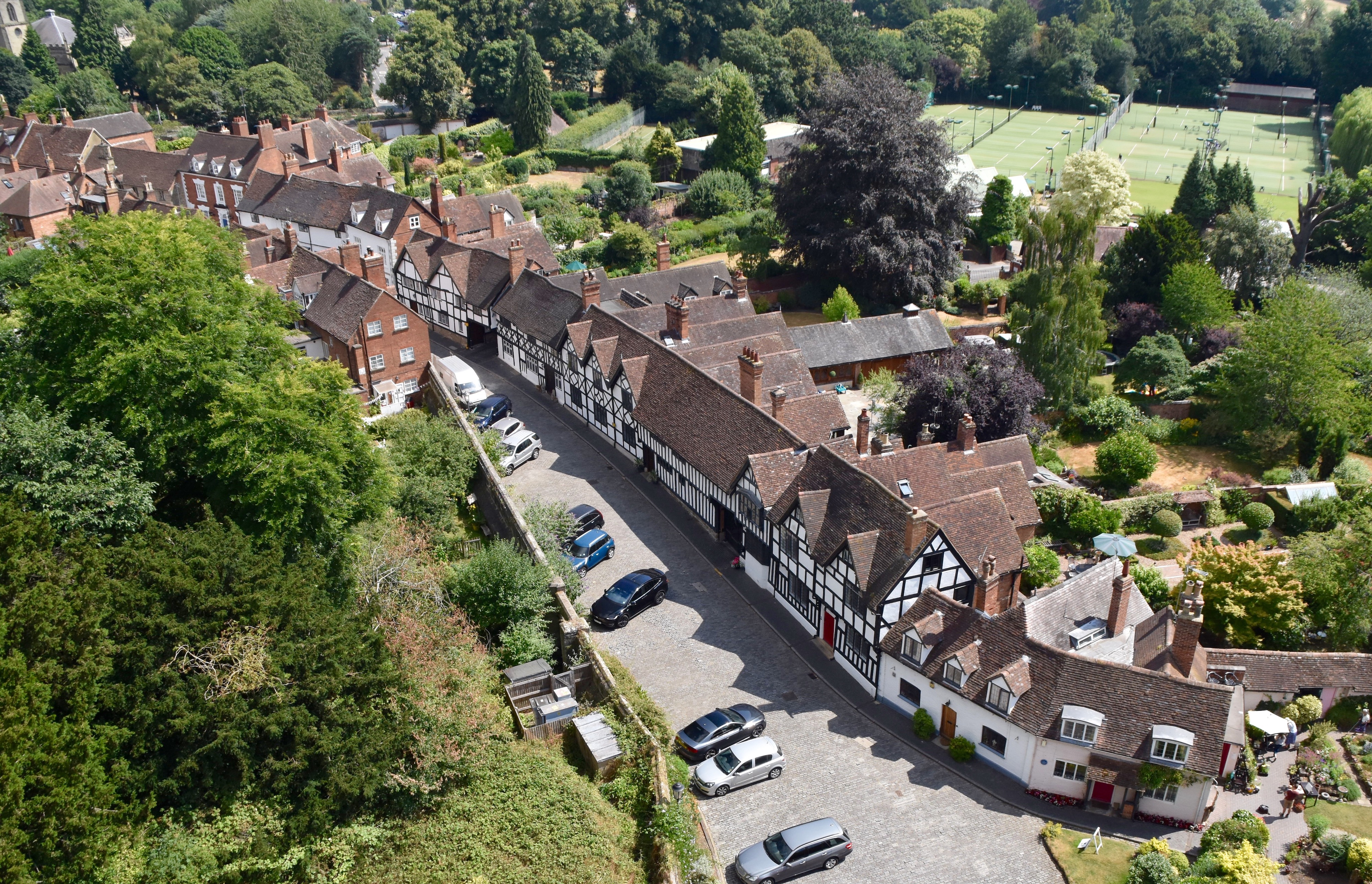
Looking in the other direction you can see the jousting grounds on the other side of the River Avon. They do actually have jousting at Warwick Castle which I would dearly have loved to see, but not on the day we visited. The giant erection in front of the jousting grounds is the trebuchet which will see in action later on the visit.
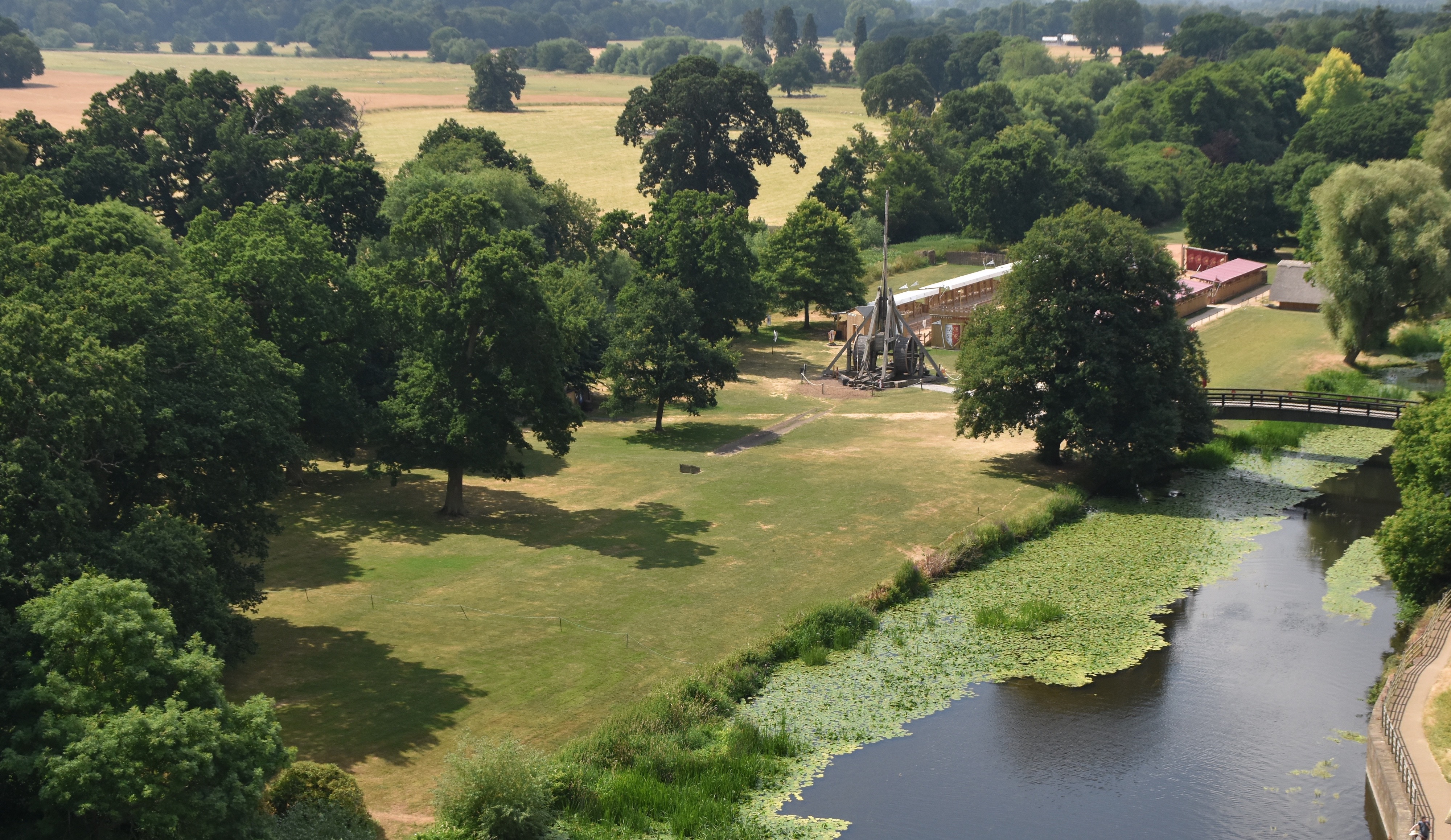
From Caesar’s Tower it’s all downhill, in fact it seems like the stairs will never end, but they do, in the basement area where there are more wax tableaux. Here’s my sister Anne with two Ladies-in-Waiting.
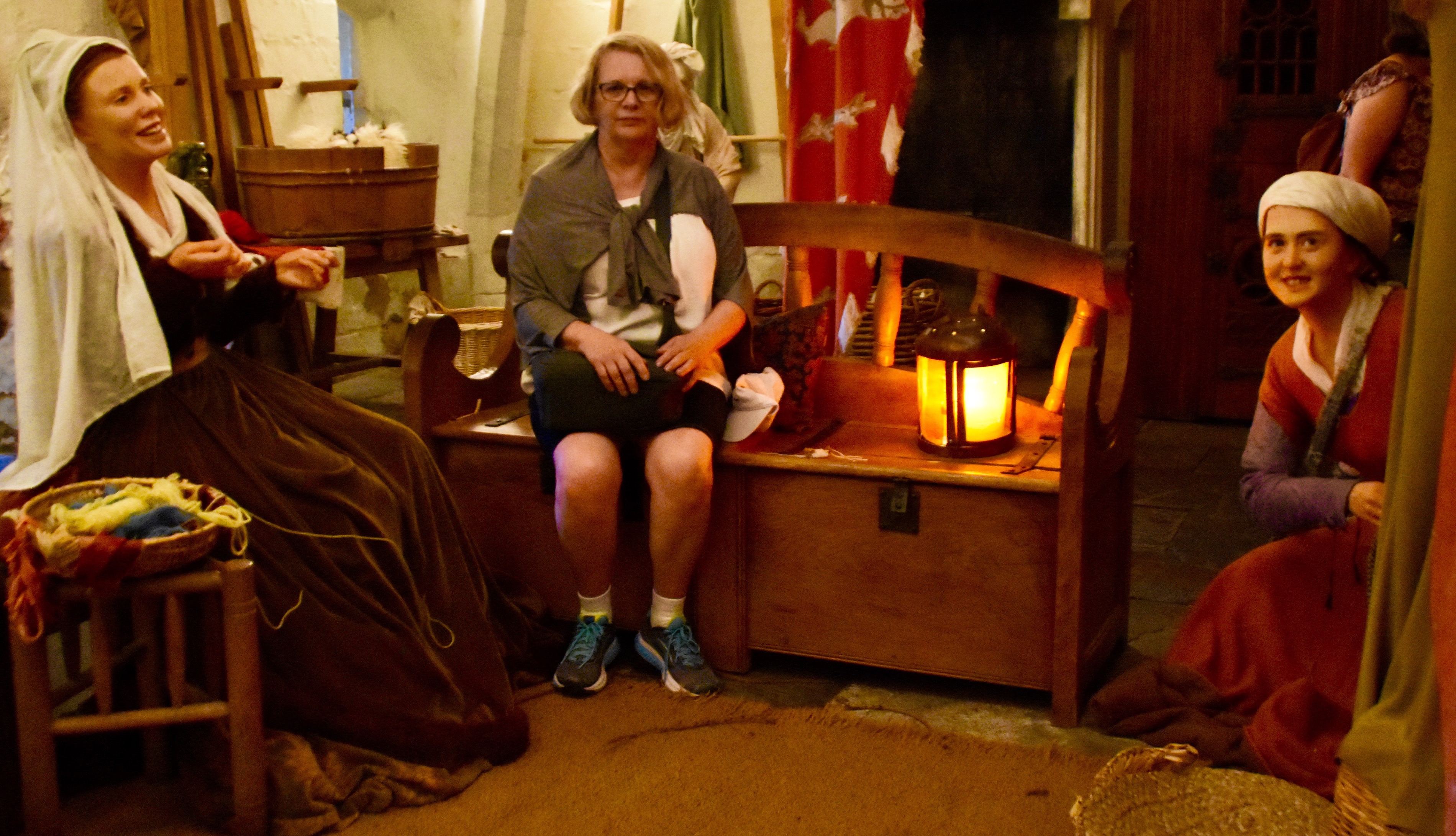
By now our time was running short and it was time to explore outside the castle and head for the trebuchet display. Along the way we ran into our tour leader Phil Craig taking a turn trying to use an English longbow. All I can say is thank God he wasn’t at Agincourt or we might have lost.
We also came across this lady leaded her flaxen haired knight to the trebuchet.
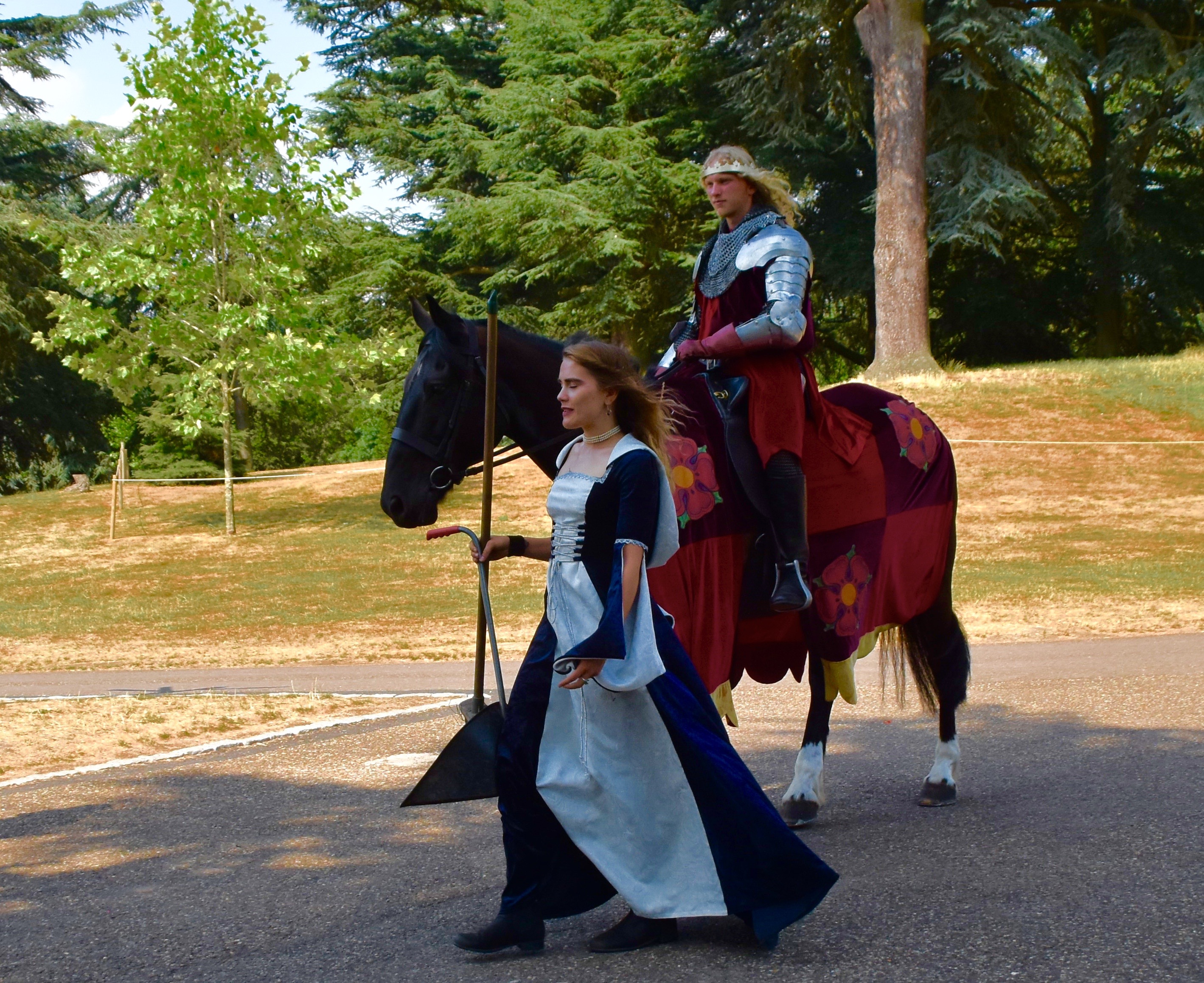
So what exactly is a trebuchet? Really nothing more than a giant catapult and Warwick Castle just happens to have the largest one in existence. It was machines like this that led to the successful siege of Warwick Castle by Simon de Montford.
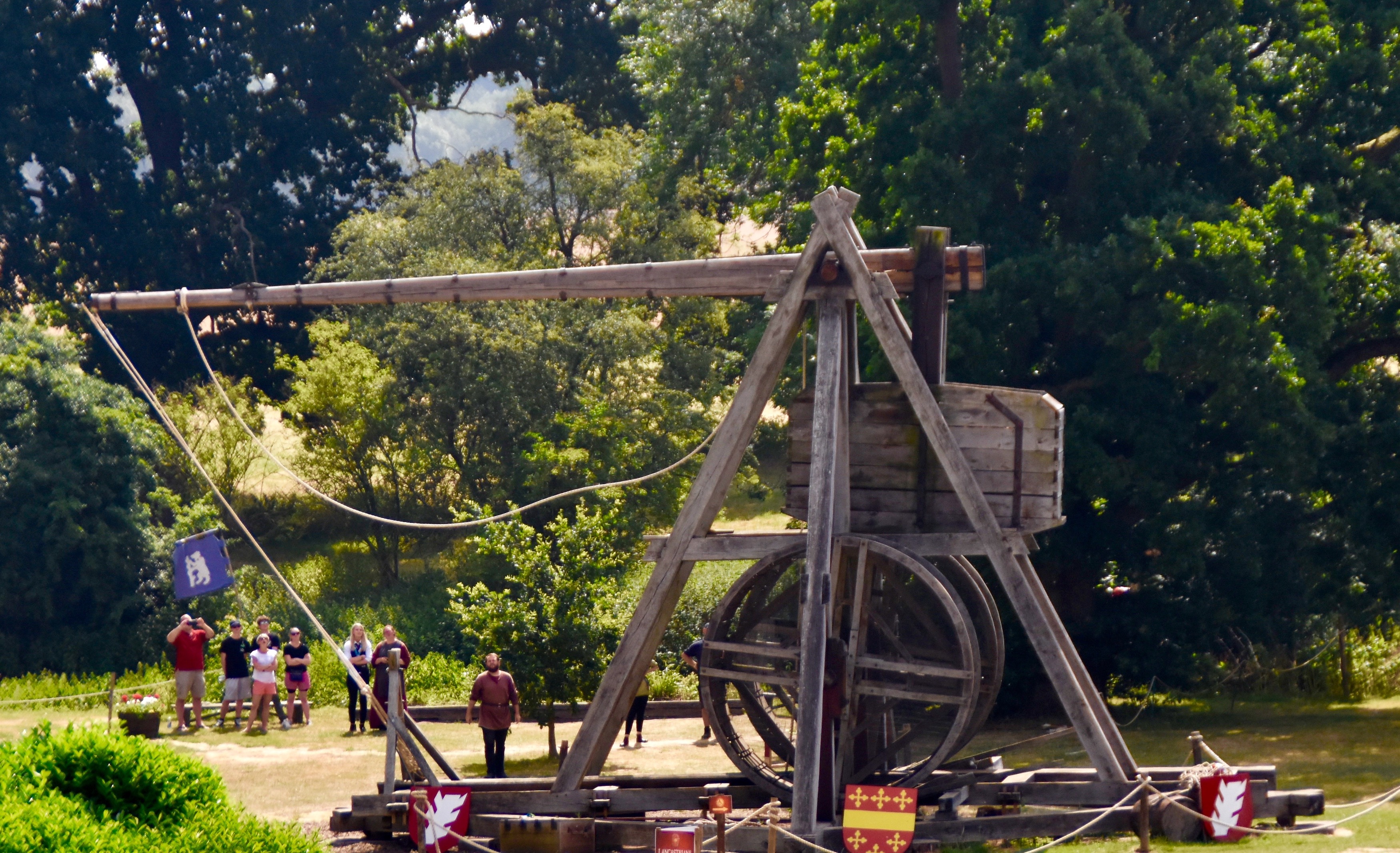
And here’s what it looked like in action from this You Tube video.
And they didn’t just fling stones or flaming missiles, but often dead animals and even humans to spread disease inside the besieged castle. On those pleasant thoughts I’ll end our tour of Warwick Castle. I know there were some in our group who thought the place too ‘Disneyfied’, but I’m not one of them. This place just has too much history and so much fits the description of a medieval castle that I can more than overlook the fact that in order to keep up a place of this magnitude you need to give the masses some ‘bread and circus’ entertainment as well.
On our next stop Liberation Tours will take us to a re-enactment of the Battle of Tewkesbury. Should be a hoot. Hope you’ll join us.

